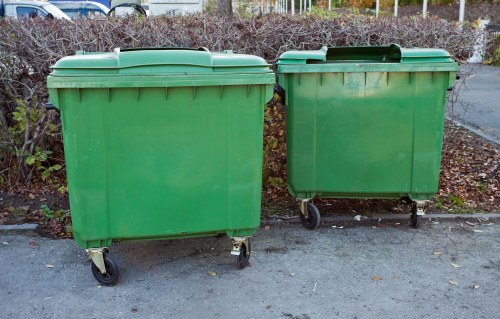Furniture Disposal in Cranford: Your Comprehensive Guide

Are you looking to responsibly dispose of your old furniture in Cranford? Whether you're upgrading your home, decluttering, or moving, understanding the best disposal methods is crucial. Proper furniture disposal not only helps maintain a clean environment but also ensures that items are recycled or donated whenever possible.
In Cranford, several options are available for furniture disposal, each catering to different needs and preferences. This guide will walk you through the most effective and eco-friendly ways to get rid of your unwanted furniture.
Before diving into the various methods, it's essential to consider the condition of your furniture and your personal preferences regarding donation or recycling. This initial assessment will help you choose the most suitable disposal method.
Why Proper Furniture Disposal Matters

Proper furniture disposal is more than just a matter of cleanliness. It plays a significant role in environmental conservation and community well-being. By disposing of furniture responsibly, you reduce the amount of waste that ends up in landfills, minimize pollution, and promote the reuse of valuable resources.
Moreover, responsible disposal can support local charities and organizations that provide furniture to those in need. Donating your old furniture can make a positive impact on your community, offering others the opportunity to benefit from items they might not afford otherwise.
Failure to dispose of furniture correctly can lead to unnecessary environmental degradation and missed opportunities for recycling and donation. It's essential to take proactive steps to ensure your furniture disposal aligns with both environmental and social responsibility.
Options for Furniture Disposal in Cranford
1. Donation Services

Donating your furniture is an excellent way to give back to the community while ensuring your items are put to good use. Numerous organizations in Cranford accept gently used furniture, including local charities, non-profits, and thrift stores.
**Benefits of Donating Furniture:**
- Environmental Impact: Reduces landfill waste and promotes recycling.
- Community Support: Helps individuals and families in need.
- Tax Deductions: Eligible donations may qualify for tax benefits.
Before donating, ensure your furniture is in good condition. Contact the organization beforehand to confirm their requirements and schedule a pickup if necessary.
Many local charities in Cranford offer free pickup services, making the donation process convenient and hassle-free.
2. Recycling Centers

Recycling centers in Cranford provide a sustainable option for disposing of furniture. These centers process materials to be reused in new products, minimizing environmental impact.
**How Recycling Works:**
- **Disassembly:** Furniture is broken down into its component parts.
- **Material Sorting:** Materials such as wood, metal, and plastic are separated.
- **Processing:** Each material type is processed and prepared for manufacturing new products.
Choosing to recycle your furniture helps conserve natural resources and reduces the demand for raw materials in production.
Contact local recycling centers to understand their acceptance policies and arrange for drop-off or pickup services.
Local Furniture Disposal Services
[h4]Professional Disposal Services[/h4]For those who prefer a more hands-off approach, professional furniture disposal services in Cranford offer convenience and efficiency. These services handle the entire disposal process, including transportation and proper disposal.
Advantages of Professional Services:
- Time-saving and convenient.
- Ensures compliance with local disposal regulations.
- Provides options for recycling and donation.
When selecting a disposal service, consider factors such as pricing, availability, and customer reviews to ensure you choose a reputable provider.
Many companies offer flexible scheduling and can accommodate same-day or next-day pickups, making it easier to manage your disposal needs.
[h4]Bulk Waste Collection Programs[/h4]The local government of Cranford may offer bulk waste collection programs, allowing residents to dispose of large items like furniture during scheduled pickups.
Key Features:
- Scheduled collection dates.
- Designated drop-off points.
- Guidelines on acceptable items and preparation.
Check with the Cranford municipal services to learn about the availability and specifics of bulk waste collection in your area.
Proper preparation, such as disassembling large pieces and securing items, can facilitate a smooth disposal process.
DIY Furniture Disposal Tips
Preparing Your Furniture for Disposal
If you choose to dispose of furniture yourself, following some best practices can make the process more efficient and environmentally friendly.
Here are some **DIY disposal tips**:
- Assess the Condition: Determine if the item can be repaired, recycled, or should be discarded.
- Clean and Repair: Clean the furniture and make minor repairs to increase its chances of being reused or donated.
- Disassemble: Break down large pieces to save space and make transportation easier.
- Sort Materials: Separate materials like wood, metal, and fabric for recycling.
Proper preparation not only streamlines the disposal process but also enhances the potential for your furniture to be reused or recycled effectively.
Additionally, consider the timing of your disposal efforts. Planning ahead can help you manage your schedule and reduce the stress associated with getting rid of large items.
Transportation and Handling
Transporting furniture to a disposal site requires careful handling to prevent damage to both the items and your property.
Consider the following:
- Use Proper Equipment: Utilize dollies, straps, and moving blankets to protect the furniture during transport.
- Safety First: Lift heavy items correctly to avoid injury.
- Secure Loads: Ensure items are securely placed in your vehicle to prevent shifting.
Taking these precautions will help you safely transport your furniture to the desired disposal location.
For larger items, renting a truck or van may be necessary to accommodate the size and weight of your furniture.
Environmental Impact of Furniture Disposal
[h3]Reducing Your Carbon FootprintChoosing eco-friendly disposal methods for your furniture contributes to reducing your carbon footprint. Recycling and donating are effective ways to minimize waste and conserve resources.
Benefits:
- **Energy Conservation:** Recycling materials requires less energy compared to producing new ones from scratch.
- **Pollution Reduction:** Proper disposal methods decrease the release of harmful substances into the environment.
- **Resource Preservation:** Reusing materials helps preserve natural resources for future generations.
By making conscious disposal choices, you actively participate in environmental conservation efforts.
Educating yourself about sustainable practices in furniture disposal can inspire others to follow suit, amplifying the positive impact on the environment.
Impact on Local Communities
Responsible furniture disposal has a direct positive impact on local communities in Cranford. Donated items can support families, individuals, and organizations in need, fostering a sense of community and solidarity.
Additionally, reducing landfill waste alleviates the burden on local waste management systems, contributing to a cleaner and healthier living environment for all residents.
By participating in local disposal initiatives, you help create a more sustainable and supportive community.
Engaging with local disposal services and charities can also build stronger community ties and promote collective efforts toward sustainability.
Legal Considerations for Furniture Disposal
[h3]Understanding Local RegulationsBefore disposing of furniture in Cranford, it's important to be aware of local regulations and guidelines. Different municipalities may have specific rules regarding the disposal of large items like furniture.
Key Points to Consider:
- **Permits and Fees:** Some areas may require permits for bulk waste disposal, along with associated fees.
- **Accepted Items:** Verify which types of furniture are accepted by local disposal services or recycling centers.
- **Disposal Schedules:** Adhere to scheduled collection dates and prepare items accordingly.
Complying with these regulations ensures that your furniture disposal is lawful and avoids potential fines or penalties.
Reach out to Cranford's municipal office or visit their official website to obtain detailed information about furniture disposal requirements.
Hazardous Materials and Special Handling
Some furniture may contain hazardous materials that require special handling during disposal. Items like electronic furniture, upholstered pieces with chemical treatments, or antique items with lead-based paints fall into this category.
Important Steps:
- Identify Hazards: Determine if your furniture has any hazardous components.
- Seek Specialized Services: Contact disposal services that handle hazardous materials safely.
- Follow Safety Protocols: Ensure that all safety measures are in place during disposal.
Properly disposing of hazardous materials prevents environmental contamination and protects public health.
If unsure about the materials in your furniture, consult with a professional before proceeding with disposal.
Choosing the Right Disposal Method for You
[h3]Assessing Your Needs and PreferencesSelecting the appropriate furniture disposal method depends on several factors, including the condition of your furniture, your timeline, and your budget.
Considerations:
- Condition: Is the furniture still usable or does it need to be discarded?
- Timeframe: Do you need immediate disposal, or can it wait for scheduled pickups?
- Cost: Are you willing to pay for professional services, or do you prefer free options like donations?
Evaluating these factors will help you make an informed decision that aligns with your specific situation.
For instance, if you have gently used furniture and prefer a no-cost option, donating might be the best choice. Conversely, if your items are unusable and require immediate disposal, professional services may be more suitable.
Comparing the Options
Let's compare the primary disposal options based on key criteria:
| Option | Cost | Environmental Impact | Convenience |
|---|---|---|---|
| Donation | Free | High | High |
| Recycling | Low | High | Medium |
| Professional Services | Varies | High | High |
| Bulk Waste Collection | Low to Free | Medium | Medium |
By examining these factors, you can choose the option that best fits your needs and values.
Remember, combining methods is also possible. For example, donating usable items while recycling the rest ensures comprehensive and responsible disposal.
Preparing for Furniture Pickup or Drop-off
[h3]Steps to Ensure a Smooth ProcessWhether you're arranging for a pickup or planning to drop off your furniture, proper preparation can simplify the process.
Here are steps to follow:
- Sort Your Furniture: Decide which items you want to donate, recycle, or dispose of.
- Clean the Items: Ensure that all furniture is clean and presentable for donation.
- Disassemble Large Pieces: Break down bulky items to save space and facilitate transportation.
- Secure Fasteners: Use tape or straps to keep disassembled parts together.
- Schedule Appropriately: Arrange pickup times that align with your availability.
Following these steps helps prevent delays and ensures that your furniture is disposed of efficiently.
Safety Precautions
When handling furniture disposal, prioritize safety to protect yourself and others involved.
Important safety tips:
- Lift Properly: Use correct lifting techniques to avoid injury.
- Use Protective Gear: Wear gloves and sturdy footwear to protect against cuts and bruises.
- Clear Pathways: Ensure that pathways are free of obstacles to facilitate easy movement of furniture.
Maintaining safety during disposal activities ensures a risk-free experience.
If you're unsure about moving large or heavy items, consider seeking assistance from professionals or knowledgeable friends.
Cost Considerations for Furniture Disposal
[h3]Understanding the Financial AspectWhile some furniture disposal methods are free, others may incur costs. Understanding these financial aspects can help you budget accordingly.
Potential Costs:
- Donation Fees: Most donation services are free, but some may charge for pickup.
- Recycling Fees: Recycling centers may charge based on the type and volume of materials.
- Professional Services: Costs vary depending on the service provider, distance, and volume of furniture.
- Bulk Waste Collection Fees: Some municipalities charge fees for bulk waste pickups.
Comparing these costs against your budget will aid in selecting the most feasible disposal method.
Additionally, factor in any potential savings from donating instead of paying for disposal services.
Maximizing Value
To maximize value and minimize costs, consider the following strategies:
- Combine Items: Bundle multiple pieces for a single donation or pickup to reduce fees.
- Schedule Efficiently: Align pickups with other errands to save both time and money.
- Explore Free Services: Utilize free donation and recycling options whenever possible.
By being strategic, you can effectively manage the financial aspect of furniture disposal.
Researching available options and comparing prices can lead to more cost-effective disposal solutions.
Eco-Friendly Disposal Practices
[h3]Sustainable Approaches to Furniture DisposalEmbracing eco-friendly disposal practices supports environmental sustainability and reduces your ecological footprint.
Practices to Consider:
- Reuse and Upcycle: Transform old furniture into new, functional pieces.
- Recycle Materials: Ensure that materials are properly recycled through designated centers.
- Choose Sustainable Services: Opt for disposal services that prioritize eco-friendly methods.
Implementing these practices contributes to a healthier environment and promotes responsible consumption.
Additionally, educating others about sustainable disposal can amplify the positive impact on the community.
Innovative Disposal Solutions
Advancements in disposal technology offer innovative solutions for furniture disposal.
Examples include:
- Furniture Take-Back Programs: Some manufacturers offer take-back services for old products.
- Modular Recycling Systems: Advanced systems that can dismantle and sort materials more efficiently.
- Composting Sustainable Materials: For furniture made with organic materials, composting can be an option.
Staying informed about these innovations can provide more effective and environmentally friendly disposal methods.
Adopting new technologies can enhance the efficiency and impact of your disposal efforts.
Community Resources and Support
[h3]Leveraging Local NetworksCranford offers various community resources that can aid in furniture disposal. Engaging with these resources ensures that your disposal efforts are supported and effective.
Available Resources:
- Local Charities: Organizations that accept furniture donations.
- Recycling Centers: Facilities that process and recycle furniture materials.
- Municipal Services: Government services that handle bulk waste and scheduling.
- Community Groups: Local groups that facilitate sharing or gifting of items.
Utilizing these resources can streamline the disposal process and ensure best practices are followed.
Additionally, networking with community members can provide insights and tips for effective furniture disposal.
Educational Workshops and Programs
Participating in local workshops and programs can enhance your understanding of furniture disposal and sustainability.
Benefits:
- Learn about best practices and innovative disposal methods.
- Connect with experts and like-minded individuals.
- Access to resources and support networks.
These educational opportunities empower you to make informed and responsible disposal choices.
Stay updated with community bulletin boards, local newspapers, and online platforms to find relevant workshops and programs.
Frequently Asked Questions (FAQs)
[h3]Common Concerns AddressedHere are some frequently asked questions about furniture disposal in Cranford:
- What items can I donate?
You can donate gently used furniture such as sofas, chairs, tables, and beds. Ensure items are clean and in good condition.
- Are there any fees for furniture pickup?
Many donation and recycling services in Cranford offer free pickup, but it's best to confirm with the provider.
- How do I prepare furniture for recycling?
Disassemble large pieces, sort materials, and secure any loose parts to facilitate the recycling process.
- Can I recycle upholstered furniture?
>
Yes, upholstered furniture can be recycled. Contact local recycling centers to understand their specific requirements.
- What should I do with broken furniture?
>
If the furniture is beyond repair, consider recycling the materials or disposing of them through bulk waste collection services.
If you have additional questions, don't hesitate to contact us today for personalized assistance with your furniture disposal needs.
Conclusion

Furniture disposal in Cranford doesn't have to be a daunting task. By exploring the various options available—donation, recycling, professional services, and DIY methods—you can find a solution that aligns with your needs and values.
Remember the importance of responsible disposal in promoting environmental sustainability and supporting the community. Properly assessing your furniture's condition and understanding local regulations will guide you in making informed decisions.
Whether you choose to donate, recycle, or use professional services, each method offers unique benefits that contribute to a cleaner and more sustainable Cranford.
Take the first step today by reaching out to local disposal services or exploring donation opportunities. Your proactive approach ensures that your old furniture is handled responsibly, benefiting both you and the broader community.
Book your service now and make a positive impact through responsible furniture disposal!